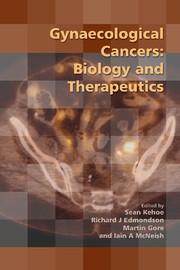Book contents
- Frontmatter
- Contents
- Participants
- Declarations of personal interest
- Preface
- SECTION 1 BIOLOGY OF GYNAECOLOGICAL CANCERS: OUR CURRENT UNDERSTANDING
- SECTION 2 THE TRANSLATION OF BIOLOGY TO THE CLINIC
- SECTION 3 IMAGING AND THERAPY: STATE OF THE ART
- 8 The role of robotics and the future
- 9 ‘Ultra-radical’ surgery in advanced ovarian cancer
- 10 Antivascular therapy in gynaecological cancers
- 11 Oncolytic viral gene therapy in ovarian cancer
- 12 Endometrial cancer: what have the clinical trials taught us?
- 13 Targeting therapies in cancer: opportunities in ovarian cancer
- 14 Functional imaging: from tumour biology to the clinic
- SECTION 4 WHAT QUESTIONS ARE BEING ASKED BY CURRENT CLINICAL TRIALS?
- SECTION 5 CONSENSUS VIEWS
- Index
14 - Functional imaging: from tumour biology to the clinic
from SECTION 3 - IMAGING AND THERAPY: STATE OF THE ART
Published online by Cambridge University Press: 05 February 2014
- Frontmatter
- Contents
- Participants
- Declarations of personal interest
- Preface
- SECTION 1 BIOLOGY OF GYNAECOLOGICAL CANCERS: OUR CURRENT UNDERSTANDING
- SECTION 2 THE TRANSLATION OF BIOLOGY TO THE CLINIC
- SECTION 3 IMAGING AND THERAPY: STATE OF THE ART
- 8 The role of robotics and the future
- 9 ‘Ultra-radical’ surgery in advanced ovarian cancer
- 10 Antivascular therapy in gynaecological cancers
- 11 Oncolytic viral gene therapy in ovarian cancer
- 12 Endometrial cancer: what have the clinical trials taught us?
- 13 Targeting therapies in cancer: opportunities in ovarian cancer
- 14 Functional imaging: from tumour biology to the clinic
- SECTION 4 WHAT QUESTIONS ARE BEING ASKED BY CURRENT CLINICAL TRIALS?
- SECTION 5 CONSENSUS VIEWS
- Index
Summary
Introduction
The increasing demand for in vivo imaging to provide early biomarkers of disease response as well as to report on predictive and prognostic features of tumours is driving the need for a combined structural and functional approach. Morphological imaging is usually only useful in assessing response late after therapy and, while volumetric measures, for example in cervical cancer, are crucial prognostic indicators, their use in small, early-stage disease is less useful in this regard. With the advent of techniques such as dynamic contrast-enhanced (DCE) computed tomography (CT) or magnetic resonance imaging (MRI), diffusion-weighted (DW) imaging, lymph node-specific contrast agents and positron emission tomography (PET) with F-FDG or other targeted radiotracers, there is a burgeoning field of ‘functional’ techniques that can be exploited for use in the clinic. This chapter describes the range of techniques available, their relationship to tumour biology and their utility in the context of patient management pathways.
Available techniques
Dynamic contrast-enhanced CT or MRI
The microvascular properties of tissue can be interrogated with DCE-CT or DCE-MRI, where rapid image acquisition before, during and after a bolus of intravenously injected contrast agent enables pharmacokinetic modelling of its passage through the circulation and into the tissue compartment. The presence of the contrast agent (iodinated in the case of CT, weakly paramagnetic in the case of MRI) increases X-ray attenuation or signal intensity, respectively; the degree of enhancement is determined by blood flow, vascular density, capillary permeability and capillary surface area in the early vascular phase and by extravascular space volume in the interstitial phase.
Keywords
- Type
- Chapter
- Information
- Gynaecological CancersBiology and Therapeutics, pp. 183 - 202Publisher: Cambridge University PressPrint publication year: 2011

